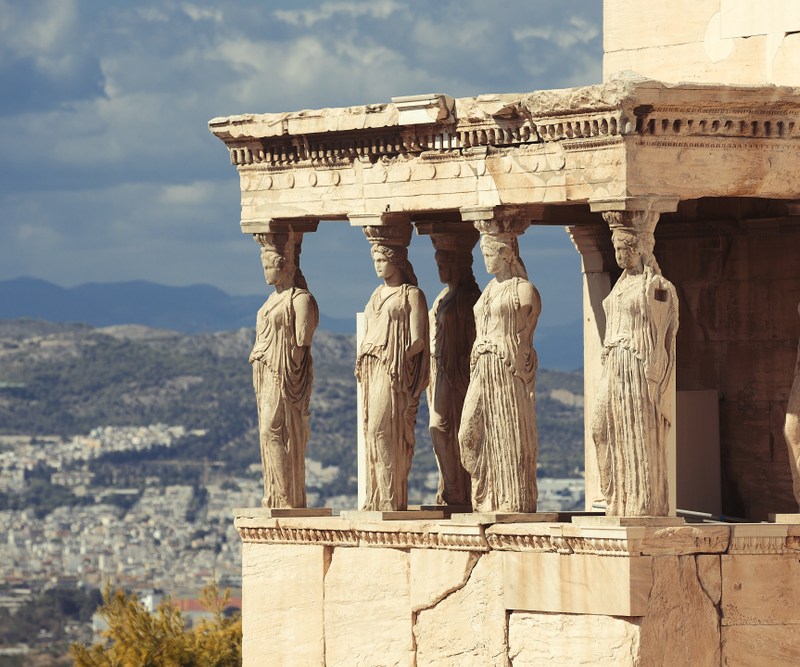
Athens is the capital city of Greece and the world’s apex of antiquity. The Greeks, and then the Romans, ruled the city for centuries, leaving their mark with massive marble monuments, coins and jewelry forged from precious metals, and exquisite pottery and artwork. Nearly 4 million people now call the city and its metropolitan area their home. Travelers from around the world go there to roam the incredible ruins and imagine ancient times, when gods and goddesses were worshipped in over-the-top temples, and both theater and athletic competitions played out in enormous open-air arenas. Here are some of the best things to see and do while in Athens.
Videos by TravelAwaits

Admire The Acropolis
This iconic hill of archeological treasures that towers above Athens is a UNESCO World Heritage site. Most of the masterpieces you’ll see there date to the fifth century B.C. and are constructed of creamy white marble. Of course, there’s the Parthenon, the massive temple dedicated to the Greek goddess Athena, with its massive Doric columns. Other standouts include the Theater of Dionysus, which played host to drama competitions between the great playwrights, and the Erechtheion, where six enormous caryatids, or stone carvings of draped female figures, balance the weight of the structure’s southwestern corner on their heads.
Tickets to explore the complex start at 20 euros; plan to spend at least half a day at this amazing world wonder.
Marvel At The Marbles
You’ll need to purchase an extra ticket, but do not skimp on or skip the Acropolis Museum. This gorgeous and modern glass building, located just across from the Acropolis complex, has a complicated history. The museum was first established in the 1860s to house artifacts uncovered at the Acropolis. It was reconfigured and rebuilt at the Acropolis several times until 2009, when the new 25,000-square-foot building was completed right next door to the ruins. The new museum is built on top of an ancient Christian site discovered during construction; visitors can gaze down at it through the glass floor.
Be sure to take a moment to view the Parthenon Gallery, which features original friezes from inside the temple as well as replicas of the marbles taken by Lord Elgin in the early 1800s. The Elgin Marbles still reside at the British Museum in London and have yet to be returned, despite protests and political pressure.
Tickets to the museum cost 10 euros during the high season (April 1 to October 31) and 5 euros during the low season.

Explore The Ancient Agora
Beneath the northwestern slope of the Acropolis lies the Agora, the marketplace of ancient Athens. The Temple of Hephaestus and the Stoa (covered walkway) of Attalos are the Agora’s main attractions. Admittedly, this site isn’t as grand as the superstar right up the hill, but consider its history. This place was the true heart of the city, serving as its main residential and commercial area for 1,500 years. Excavations here have unearthed massive collections of artifacts, including jewelry, pottery, and coins. All of these objects help illustrate what life was like in ancient Athens.
Wander The National Archeological Museum
To get another curated look at the ancient artifacts of Athens, consider a stop at the National Archeological Museum, north of the Acropolis. The museum, the largest in Greece, was founded in 1829 to be the repository for the antiquities uncovered by archeologists working not only in Athens, but across Greece. More than 11,000 pieces, including sculptures, metalworks, and intricately decorated ceramic vases and urns, are on display; many of these objects had to be spirited away to secret spots during World War Two to ensure they weren’t stolen by the Nazis. You’ll be amazed by the history and beauty crammed into this spot. Tickets are 10 euros during the high season (April 1 to October 31) and 5 euros during the low season.

See Hadrian’s Arch And The Temple Of Zeus
The Roman emperor Hadrian built numerous monuments in Athens, and the entrance to one of the most famous is also impressive. Stroll under the Arch of Hadrian, a triumphal gate to the once-grand Temple of Zeus. As you enter, be on the lookout for the inscriptions on the arch. One reads “This is Athens, the ancient city of Theseus,” and the other reads “This is the city of Hadrian and not of Theseus.” Scholars say the etchings allude to the fact that the arch stood at the boundary between the “old” and “new” sections of Athens.
Once you pass through, consider the hulking remains of the temple built to honor the king of the gods, Zeus. It once housed a 36-foot-tall statue of the deity that was crafted of gold and ivory. This place has been through the wringer since it was built back in 456 B.C.: The temple has fallen victim to numerous fires and earthquakes over the centuries. However, wandering through the massive columns that remain, it’s not hard to imagine its former glory.
Catch The Changing Of The Guard
For an old-meets-new experience in Athens, head to Syntagma (Constitution) Square. This square surrounds the Old Royal Palace, which was built for King Otto of Greece in 1843 but is now the home of the Hellenic Parliament. It’s a major public transit hub that, given its political focus, also serves as a place of protest for the people of Athens. Each day on the hour, the Evzones — costumed Greek guards keeping vigil at the Tomb of the Unknown Soldier — hold a changing of the guard ceremony. Syntagma Square’s subway station is a mini-museum, built into archaeological ruins you can view while catching your train.

Run Where The Olympics Were Born
Want to see where the original Olympics took place, and where the modern ones began? Head to the Panathenaic Stadium. Athletic competitions called the Olympiad were held at this spot from 565 B.C. until the fourth century A.D. In the 1860s, civic leaders in Athens decided to rebuild the old stadium, fashioning it from marble. The modern Olympics were revived in the stadium in 1896 and held there again in 2004. It’s an awe-inspiring spot in a city full of them.
General admission is 5 euros. You can channel your own inner Olympian during the morning jog sessions held daily from 7:30 a.m. to 9 a.m.
Stroll Through The National Garden
Need a break from buildings? That’s completely understandable; the architecture of Athens can be overwhelming. For a nice break, consider a stroll in the National Garden. Located just east of Syntagma Square, this charming oasis was part of the palace complex constructed for King Otto and Queen Amalia of Greece in 1843. The garden is home to thousands of trees, gorgeous flowering shrubs and plants, a half dozen ponds filled with friendly ducks, a greenhouse, and a small café. Be sure to check out the adjacent Zappeion Hall, which features statues and busts of gods, goddesses, kings, queens, and politicians, as well as its own surrounding gardens. This is the perfect spot to unwind after spending a day at the Acropolis or the museums. The garden is free to all.

Eating In Athens
One of the things we adored most about Athens was the food. Everything was delightfully fresh. Greek olives, just-baked pita bread, and local feta crumbles washed down with a glass of dry white Assyrtiko wine made up a quick, light lunch. We also really loved the dips, or mezze. Tzatziki, the cool cucumber-yogurt concoction, is a crowd pleaser, as is taramosalata, a spread made from fish roe. And if you love garlic, try the skordalia, a delicious potato-garlic mash-up. Be sure to sample the ubiquitous souvlaki (skewered lamb or chicken) and the world-famous, much-loved gyro sandwich. Saganaki, deep-fried Greek cheese, was another of our favorites, as was spanakopita, the spinach pie sold by street vendors and in cafés.
For a dinner splurge, consider Strofi. Located adjacent to the Acropolis, this open-air dining spot offers a million-dollar view and traditional Greek cuisine crafted with locally grown ingredients.
Shopping In Athens
When we needed a respite from the ruins, we went shopping. We did most of our buying in Plaka, an ancient area near the northeastern slopes of the Acropolis. Homes, gardens, cafés and shops are packed into this labyrinthine area with winding paths and relatively quiet lanes. It’s a great place to take a breather, grab a snack, and pick out some gifts to take home. Go to Adrianos Street for some of the best souvenir shops.
We purchased ouzo, a potent anise-flavored liquor that is the national drink of Greece. It’s worth wrapping up and stashing into your checked luggage for the trip home. It’s no surprise that you’ll also find some of the world’s best olive oil in Athens; it’s the perfect souvenir for foodies. For smaller, nonbreakable take-homes, consider kompoloi (worry beads made of coral or amber) or gorgeous hand-embroidered linens for the table or bed.
Photo Credit: Anastasios71 / Shutterstock
Photo Credit: Sven Hansche / Shutterstock
